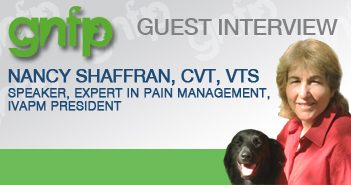UPDATED 10/11/15 — Editor’s Note: As NAVTA celebrates National Veterinary Technician Week, Ranny Green interviewed NAVTA’s president Dan Swenson. Goodnewsforpets decided to highlight yet another accomplished veterinary technician – Nancy Shaffran, CVT, VTS, the first veterinary technician to become president of the International Veterinary Academy of Pain Management (IVAPM). Editor & Publisher Lea-Ann Germinder first met Nancy Shaffran a few years ago during the Zoetis (formerly Pfizer) Know Heartworms campaign with the American Heartworm Society and the American Association of Feline Practitioners. Since Nancy’s area was pain management, we first met at the International Veterinary Emergency & Critical Care Society (IVECCS) meeting. It’s no surprise to us that Nancy has assumed the helm of IVAPM and Goodnewsforpets looks forward to hearing more from IVAPM during her year as president.
How did you decide to become a certified veterinary technician?
I always say that no one chooses veterinary medicine, veterinary medicine chooses you. From the time I was three years old I told my parents I wanted to be a vet. What surprised me was that I didn’t go to veterinary school, because when I got to the University of Pennsylvania, I worked in the field of nursing and I was hooked.
How did you become interested in the area of pain management?
I spent 13 years at the University of Pennsylvania Veterinary School, where I became the director of the intensive care unit. I was so frustrated that ICU would get more chaotic as the day progressed and I couldn’t do much about treating animal pain. At that time, there was a concern that if you gave any medications, medical issues would be masked. We just didn’t know much about it. As a result, I started studying human pediatric pain management, and then I left Penn to start lecturing independently about pain management.
Have pet owners and veterinarians become more savvy about recognizing pain in their pets?
It definitely has become mainstream for both pet owners and veterinarians. There was a time when we would ask, “Do animals feel pain?” In fact, it was the title of my very first lecture years ago and the room was packed. It says that everyone recognized this was an issue we needed to address. Now we want to be sure the right information is getting out there – to both general practice veterinarians and for the pet owner to know what to look for and seek veterinary care for their pet.
How far has the field of pain management come?
I have been privileged to be a part of this field since its infancy, one of the original people who dreamed about an Academy of Pain Management so you can imagine how overjoyed I am to see all this focus on pain management. In fact I just finished a editing a pain management textbook that has recently been published.
We are educating the pet owner to look for the signs of pain, encouraging pet owners to talk to their veterinarians about pain management, and for veterinarians to talk to pet owners more about pain management. There were handouts available to our veterinary members, posters in the clinics – and there will be more to come as the month gets established.
What are all the pain management options available through the veterinarian to pet owners for their pets?
I would divide pain management into three groups: pharmaceutical options, integrated options such as laser therapy and acupuncture, and physical rehabilitation options. We are taking a more holistic approach to pain management.
How can a pet owner tell if a cat is in pain?
We have a cat owner handout available. The big issue for cats is recognizing there is pain because cats are so good at hiding their pain. Very rarely will a cat be diagnosed early. In most cats, by the time they are taken to a veterinarian, we are not only dealing with the initial pain but also neuropathic pain.
Are cat owners aware of what options are available?
They may not be. There are more options for pain management for cats than ever before.
How do dogs show pain?
Dogs show pain in different ways and since dog owners participate in more activities with their dog than cat owners, they may be able to recognize their animal is changing sooner. This may include difficulty jumping or tiring more quickly during exercise. What dog owners need to know is that dogs are not changing their mobility because they are old and tired – they are most likely in pain.
What do you see for the future of pain management in pets?
In the future I see a continued move to more therapeutics and less reliance on palliative drugs. We don’t want to treat pets long-term with narcotics, which should be reserved for post-operative surgical pain and end of life comfort. Instead we try to treat the underlying pain condition and correct or control it.
Is there anything else you would like to add?
I’m really thrilled that I am taking on the presidency of IVAPM. This is an amazing organization and they encouraged this to happen — to have a nonveterinarian as president. It says a lot about the organization, but it also says a lot about the profession, that pain management is something we all need to be a part of.
For more information on IVAPM or Animal Pain Awareness Month, visit www.ivapm.org.
Nancy Shaffran CVT, VTS (ECC) is a lecturer, private consultant, president of IVAPM, CE Chair of the Atlantic Coast Veterinary Conference. She can be reached at Nshaff@aol.com.

